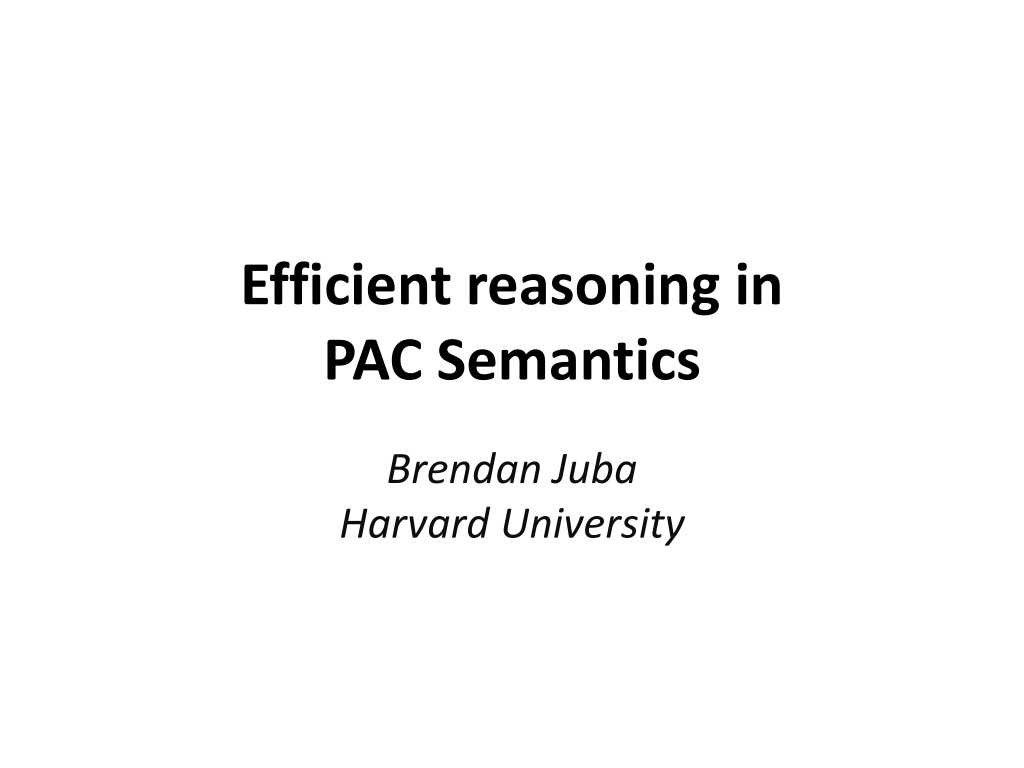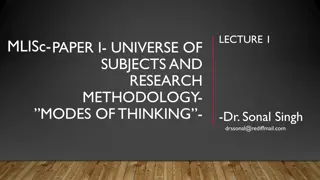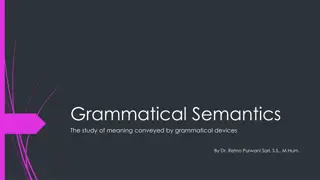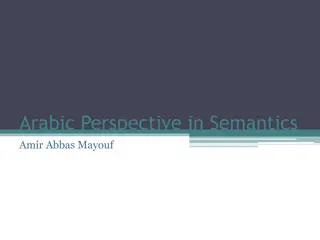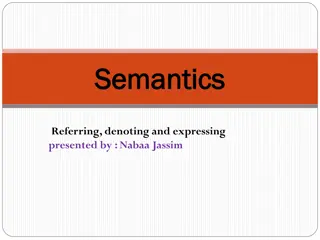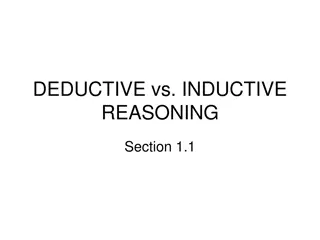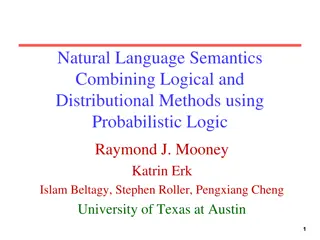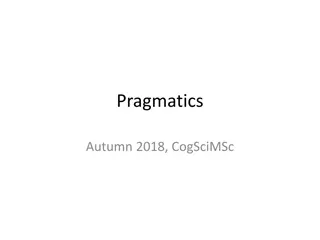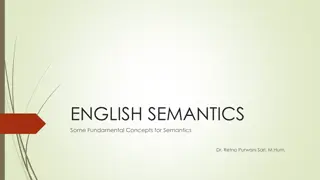Understanding PAC Semantics: Efficient Reasoning in Knowledge Acquisition
PAC Semantics, as explained by Brendan Juba from Harvard University, focuses on efficient reasoning in knowledge acquisition. The concept involves validating rules of thumb, models of partial information, utilizing such information, and developing algorithms for simpler distributions. It addresses the challenge of deriving knowledge from data accurately and efficiently, while acknowledging the limitations of traditional logic and probability-based approaches in machine learning.
Download Presentation

Please find below an Image/Link to download the presentation.
The content on the website is provided AS IS for your information and personal use only. It may not be sold, licensed, or shared on other websites without obtaining consent from the author. Download presentation by click this link. If you encounter any issues during the download, it is possible that the publisher has removed the file from their server.
E N D
Presentation Transcript
Efficient reasoning in PAC Semantics Brendan Juba Harvard University
Outline 1. What is PAC Semantics? 2. Validating rules of thumb part 1 3. Models of partial information 4. Utilizing partial information (validating rules of thumb part 2) 5. Algorithms for simpler distributions
A silly application Day Bird no. Food DO THEY FLY? 107 48 Seed 107 49 Grubs PENGUIN FLY PENGUIN EAT(FISH) 107 50 Mouse 107 51 Mouse 107 52 Worm 107 53 Seed 107 54 Mouse EAT(FISH) (p = .99) 107 55 Grubs THEY DO FLY! DATA MINING!
A silly application Day Bird no. Food DO THEY FLY? 107 48 Seed 107 49 Grubs PENGUIN FLY PENGUIN EAT(FISH) 107 50 Mouse 107 51 Mouse 107 52 Worm 107 53 Seed 107 54 Mouse EAT(FISH) (p = .99) 107 55 Grubs THEY DO FLY! DATA MINING!
PAC Learning w.p. 1- over D (x 1,x 2, ,x n) C C c(x 1,x 2, ,x n ) (x(1)1,x(1)2, ,x(1)n,c(x(1)1,x(1)2, ,x(1)n)) (x(2)1,x(2)2, ,x(2)n, c(x(2)1,x(2)2, ,x(2)n)) (x(1)1,x(1)2, ,x(1)n,x(1)t) (x(2)1,x(2)2, ,x(2)n,x(2)t) (x(m)1,x(m)2, ,x(m)n, c(x(m)1,x(m)2, ,x(m)n)) w.p. 1- over (x(m)1,x(m)2, ,x(m)n,x(m)t) f(x 1,x 2, ,x n) e.g., CONJUNCTIONS, DECISIONTREES C f
The core conflict Learned rules are taken as fact in the analysis What happens if we apply logical inference to the rule f(x) = xt produced by PAC-learning? PAC-learning f(x) for xt only guarantees that f(x) agrees with xton a 1- fraction of the domain. Knowledge derived from data (examples) is, in general, not valid in Tarski s sense THE USUAL SEMANTICS OF FORMAL LOGIC.
Why not use Probability logic? We aim for efficient algorithms (not provided by typical probability logics) Bayes nets/Markov Logic/etc.? Learning is the Achilles heel of these approaches: Even if the distributions are described by a simple network, how do we find the dependencies?
PAC Semantics (Valiant, 2000) is a weaker standard that captures the utility of knowledge derived from data, conclusions drawn from such knowledge, etc. and permits efficient algorithms
PAC Semantics (for propositional logic) Recall: propositional logic consists of formulas built from variables x1, ,xn, and connectives, e.g., (AND), (OR), (NOT) Defined with respect to a background probability distributionD over {0,1}n (Boolean assignments to x1, ,xn) Definition. A formula (x1, ,xn) is (1- )-valid under D if PrD[ (x1, ,xn)=1] 1- . A RULE OF THUMB
A silly application Day Bird no. Food DO THEY FLY? 107 48 Seed 107 49 Grubs PENGUIN FLY PENGUIN EAT(FISH) 107 50 Mouse 107 51 Mouse 107 52 Worm 107 53 Seed 107 54 Mouse EAT(FISH) (p = .99) 107 55 Grubs YOU FORGOT ABOUT EMUS! THEY DO FLY! DATA MINING!
Outline 1. What is PAC Semantics? 2. Validating rules of thumb part 1 3. Models of partial information 4. Utilizing partial information (validating rules of thumb part 2) 5. Algorithms for simpler distributions
Unintegrated Integrated Examples: x1,x2, ,xm Our question: given a query and sample of assignments (independently) drawn from D, is (x1, ,xn) (1- )-valid? Examples: x1,x2, ,xm Learning Algorithm Combined Learning+ Reasoning Algorithm Such query validation is a useful primitive for Predicting in special cases, e.g., xt Policy evaluation (and construction) Rules: 1, 2, , k Reasoning Algorithm Query: Given , intervention produces outcome Query: Query: Decision: accept/reject Decision: accept/reject
The basic theorem Theorem For every natural tractable proof system, there is an algorithm that simulates access to all rules that can be verified (1- )-valid on examples when searching for proofs.
The full-information setting is easy For a set of query formulae Q of size |Q|, given O((1/ 2)(ln|Q|+ln(1/ ))) examples from D, with probability 1- , the fraction of examples satisfying every Q is within of its validity
But, in most situations where logical inference is of interest, only partialinformation is available
Revisiting the silly application Day Day Bird no. Bird no. Food Food Flies Bird DO THEY FLY? 107 107 48 48 Seed Seed ? ? 107 107 49 49 Grubs Grubs ? ? PENGUIN FLY PENGUIN EAT(FISH) 107 107 50 50 Mouse Mouse ? ? 107 107 51 51 Mouse Mouse ? ? 107 107 52 52 Worm Worm ? ? 107 107 53 53 Seed Seed ? ? 107 107 54 54 Mouse Mouse ? ? EAT(FISH) (p = .99) 107 107 55 55 Grubs Grubs ? ? THEY DO FLY! DATA MINING!
But, in most situations where logical inference is of interest, only partialinformation is available Generally: situations where Data is unavailable because it is hard to collect or was not collected and A theory (background knowledge) exists relating the observed data to the desired data Example: Medicine & Biology
Outline 1. What is PAC Semantics? 2. Validating rules of thumb part 1 3. Models of partial information 4. Utilizing partial information (validating rules of thumb part 2) 5. Algorithms for simpler distributions
Masking processes Examples will be {0,1,*}-valued The * corresponds to a hidden value (from {0,1}) A masking functionm : {0,1} n {0,1,*}n takes an example (x1, ,xn) to a masked example by replacing some values with * A masking processM is a masking function valued random variable NOTE: the choice of variables to hide may depend on the example!
Example: independent masking Ind (x) = s.t. for each i, i = xi w.p. independently (and i = * otherwise) Appears in (Decatur-Gennaro COLT 95),(Wigderson-Yehudayoff FOCS 12), among others
Henceforth, we obtain = m(x): M D (x1,x2, ,xn) m = (Validity still defined using D as before)
Outline 1. What is PAC Semantics? 2. Validating rules of thumb part 1 3. Models of partial information 4. Utilizing partial information (validating rules of thumb part 2) 5. Algorithms for simpler distributions
Reasoning: Resolution (RES) A proof system for refuting CNFs (AND of ORs) Equiv., for proving DNFs (ORs of ANDs) Operates on clauses given a set of clauses {C1, ,Ck}, may derive ( weakening ) Ci l from any Ci (where l is any literal a variable or its negation) ( cut ) C i C jfrom Ci=C i x and Cj=C j x Refute a CNF by deriving empty clause from it
Tractable fragments of RES Bounded-width Treelike, bounded clause space xi xi xi xj xi xj
Since resolution is sound, when there is a proof of our query from a (1- )-valid CNF under D, then is (1- )-valid under D as well. {0,1}n useful when there is another CNF that is easier to test for (1- )-validity using data sat. sat.
Testable formulas Definition. A formula is (1- )-testable under a distribution over masked examples M(D) if Pr M(D)[ | =1] 1-
Restricting formulas Given a formula and masked example , the restriction of under , | , is obtained by plugging in the values of ifor xi whenever i * (i.e., | is a formula in the unknown values)
Testable formulas Definition. A formula is (1- )-testable under a distribution over masked examples M(D) if Pr M(D)[ | =1] 1- Observation: equal to is a tautology given in standard cases where this is tractable, e.g., CNFs, intersections of halfspaces; remains We will aim to succeed whenever there exists a (1- )-testable formula that completes a simple proof of the query formula tractable in cases where this is not, e.g., 3-DNFs
Unintegrated Integrated Examples: x1,x2, ,xm Examples: x1,x2, ,xm Learning Algorithm Combined Learning+ Reasoning Algorithm Useful, testable rules: 1, 2, , k Rules: 1, 2, , k Query: Reasoning Algorithm Query: Decision: accept/reject Decision: accept/reject
The basic theorem, revisited We will distinguish the following: The query is not (1- )-valid There exists a (1- )-testable formula for which there exists a [space-s treelike] resolution proof of the query from LEARN ANY THAT HELPS VALIDATE THE QUERY . N.B.: MAY NOT BE 1-VALID
Tractable fragments of RES Bounded-width Treelike, bounded clause space Applying a restriction to every step of proofs of these forms yields proofs of the same form (from a refutation of , we obtain a refutation of | of the same syntactic form)
The basic algorithm Given a query DNF and { 1, , k} For each i, search for [spaces]refutation of | i If the fraction of successful refutations is greater than (1- ), accept , and otherwise reject. CAN ALSO INCORPORATE A BACKGROUND KNOWLEDGE CNF
Analysis Note that resolution is sound So, whenever a proof of | i exists, was satisfied by the example from D If is not (1- - )-valid, tail bounds imply that it is unlikely that a (1- ) fraction satisfied On the other hand, consider the [space-s] proof of from the (1- + )-testable CNF With probability (1- + ), all of the clauses of simplify to 1 The restricted proof does not require clauses of
Also works for Bounded width k-DNF resolution L1-bounded, sparse cutting planes Degree-bounded polynomial calculus (more?) REQUIRES THAT RESTRICTIONS PRESERVE THE SPECIAL SYNTACTIC FORM SUCH FRAGMENTS ARE NATURAL (BEAME- KAUTZ-SABHARWAL, JAIR 2004)
Simultaneously reasoning and learning (1- )-testable formulas from partial information is no harder than classical reasoning alone in essentially all natural tractable fragments. Are there cases where it is easier?
Outline 1. What is PAC Semantics? 2. Validating rules of thumb part 1 3. Models of partial information 4. Utilizing partial information (validating rules of thumb part 2) 5. Algorithms for simpler distributions
Unsupervised parity learning Parity learning: assume xt = i Sxi for some S Equivalently: 0= xt ( i Sxi) More generally: x satisfies Ax = b over F2 Affine distribution the uniform distribution over solutions We hope to learn to reason about the parity constraints using partial examples (Even with 1/ ,1/ poly(n)) Theorem. It is NP-hard to distinguish w.p. 1- , for p Q[x1, xn] of O(log2(n))-degree and an affine distribution D, whether [p(x1, ,xn)=0] is (1- )-valid for D or at most -valid using quasipolynomially many examples from Ind (D). Moral:still a hard example but, PCR/RES get easier!
Theorem: There is a quasipolynomial-time algorithm that, given access to examples from Ind (D) for affine distribution D distinguishes ( + )-valid CNF under D from CNF for which there exists a CNF that is (1- + )-testable and there is a resolution refutation of of a given size p(n) with probability 1- . cf. n n-TIME ALGORITHMS NOT:TREELIKE, BOUNDED-DEGREE, etc
Bias gap distributions Suppose: given a tuple of literals (l*,l1, ,lk), Pr[l*=1|l1, ,lk] and Pr[l*=0|l1, ,lk] . We then say l* is -balancedfor (l1, ,lk). Suppose: given a tuple of literals (l*,l1, ,lk), Pr[l*=b|l1, ,lk] 1- for some b. We then say l* is (1- )-implied by (l1, ,lk). If for every tuple of distinct literals (l*,l1, ,lk), l* is either -balanced or (1- )-implied, then the distribution has a ( , 1- )-bias gap
Bias gap distributions If for every tuple of distinct literals (l*,l1, ,lk), l* is either -balanced or (1- )-implied, then the distribution has a ( , 1- )-bias gap Uniform distribution over solutions to a system of parity constraints has a ( ,1)-bias gap
Theorem: There is a quasipolynomial-time algorithm that, given access to examples from Ind (D) for Dwith a ( , 1-q(n))-bias gap (for a quasipolynomially small q(n)) distinguishes ( + )-valid polynomial system under D from Polynomial systems for which there exists a polynomial system that is (1- + )-testable and there is a polynomial calculus with resolution refutation of of size p(n) with probability 1- . PCR: derive [-1=0] using linear combination or multiplication by xi or xi, given Boolean axioms [xi2=xi] and complementarity axioms [1-xi= xi]
Theorem: There is a quasipolynomial-time algorithm that, given access to examples from Ind (D) for ( , 1)-bias gap distribution D distinguishes ( + )-valid CNF under D from CNF for which there exists a CNF that is (1- + )-testable and there is a resolution refutation of of a given size p(n) with probability 1- .
Warm-up: uniform distribution Under Ind (Un) (constant ) Clauses of width (log ) are (1- )-testable Theorem, uniform case: width-based alg : x = 0 y = * z = 0 x y z y z : width O(log )
Generalizing to affine distns Clauses with subclauses of width (log ) containing only balanced tuples (l*, l1, , lk) are also (1- )-testable Suppose b=1 for all implied subclauses that is, Pr[l*=1| l1, , lk] = 1 for l* l1 lk Clauses with (log ) such subclauses are also (1- )-testable Final case: clauses s.t. every subclause of width (log ) contains a subclause with b=0
Handling negative bias Final case: clauses s.t. every subclause of width (log ) contains a subclause with b=0 i.e. they have a subclause l* l1 lk of width O(log ) with Pr[l*=0| l1, , lk] = 1 l* l1 lk is 1-valid and of width O(log ) Use it to eliminate l* via cut rule We can learn narrow (1- )-valid clauses from examples where they are unmasked (Ind (D))
Learning all narrow clauses Can learn narrow (1- )-valid clauses from examples where they are unmasked (Ind (D)) Clauses of width O(log n) are simultaneously unmasked with probability poly(n) Independent masks the validity of narrow clauses can be estimated from these examples Setting : the conjunction of all O(log n)-width (1-q(n))-valid clauses is (1- )-valid
The algorithm. Learn all O(log n)-narrow (1-q(n))-valid clauses from examples with the clause unmasked. Use these narrow clauses to eliminate literals from input query. Search for O(log n)-narrow refutations of restrictions of the query + narrow clauses under masked examples. (Use basic alg.)
Why is there a narrow refutation? : width 2C log n width C log n width C log n The only surviving wide clauses have, in every narrow subclause l* l1 lk a literal l* with Pr[l*=0| l1, , lk] = 1
Why is there a narrow refutation? The only surviving wide clauses have, in every narrow subclause l* l1 lk a literal l* with Pr[l*=0| l1, , lk] = 1 l* l1 lk is 1-valid & of width O(log n) width 2C log n width C log n l*3 width C log n l*2 l*1 Inductively overall width 2C log n width C log n Learned clauses
